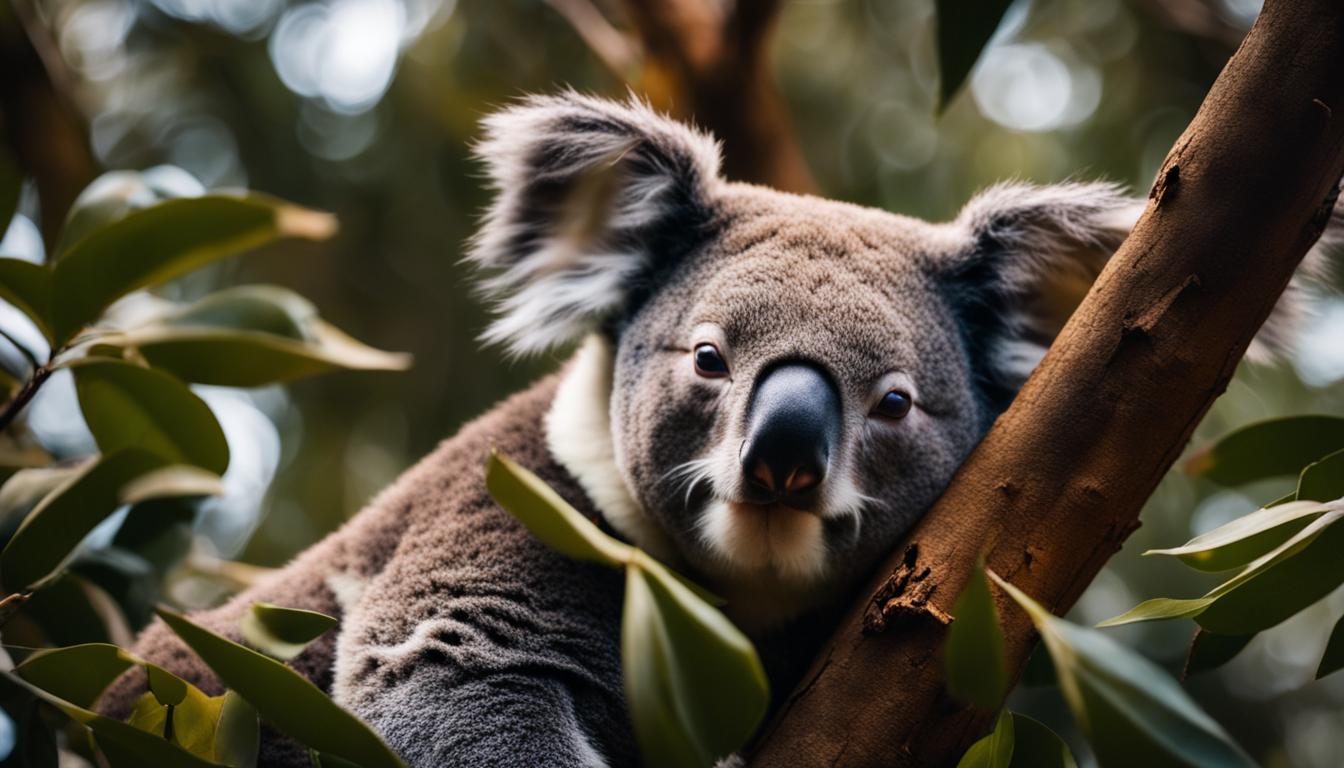Welcome to our article on koala sleep patterns, behavior, and habits. Have you ever wondered how much time these adorable creatures spend snoozing? Well, you’re about to find out!
Koalas are known for their unique sleep habits and can spend up to 20 hours a day in slumber. That’s a significant amount compared to other animals. So, why do they sleep so much?
These sleepy marsupials have specific sleep patterns influenced by their low-energy diet and the need to conserve energy. Their primary food source, eucalyptus leaves, have low nutritional value. As a result, koalas need extended periods of rest and sleep to digest their food and maintain their energy levels.
As you can see from the image above, this adorable koala is peacefully snoozing away, showcasing their unique sleep habits. Koalas have adapted to their diet by having a slow metabolism and specialized digestive mechanisms that allow them to extract energy from the toxic leaves of the eucalyptus. These leaves also act as a natural insect repellent, further aiding their peaceful slumber.
Now that you have a glimpse into their sleep patterns and habits, let’s dive deeper into the duration and adaptations of koala sleep in the next section.
Koala Sleep Duration and Adaptations
Koalas have a unique sleep pattern that sets them apart from other animals. They are known for sleeping for more than 20 hours a day, which is necessary for them to conserve energy and digest their low-energy diet of eucalyptus leaves. This extended sleep duration is an adaptation to their specialized diet and lifestyle.
Koalas have slow metabolisms and specialized digestive mechanisms that allow them to extract energy from the toxic leaves of eucalyptus trees. These leaves are not very nutritious, so koalas need to spend a significant amount of time resting and sleeping to process their food efficiently. Additionally, eucalyptus leaves contain toxins that act as a natural insect repellent, and koalas have developed a unique ability to tolerate these toxins.
Table: Adaptations of Koalas for their Sleep Patterns
| Adaptation | Description |
|---|---|
| Slow metabolism | Koalas have a slow metabolism that allows them to conserve energy during their long periods of sleep. |
| Specialized digestive mechanisms | Koalas have adaptations in their digestive system that enable them to extract energy from the low-nutrient eucalyptus leaves. |
| Tolerance to toxins | Koalas have developed the ability to tolerate the toxins in eucalyptus leaves, which act as a natural insect repellent. |
Koalas’ extended sleep duration and unique adaptations are essential for their survival in their natural habitat. Understanding their sleep patterns and adaptations is crucial for their conservation and ensuring their continued existence in the wild.
Sources:
- National Geographic – Koala
- Australia Zoo – Koalas
Koala sleep cycles and nocturnal activity
When it comes to sleep, koalas have adapted to a unique sleep cycle that aligns with their nocturnal lifestyle. These fascinating creatures are mostly active at night and during the early morning and evening hours, allowing them to avoid predators and conserve energy. Studies have shown that koalas have sleep cycles that last for a few hours, followed by short periods of wakefulness. This pattern helps them maintain their energy levels and ensures their survival in their natural habitat.
During their active periods, koalas engage in various activities such as feeding, grooming, and socializing. They are known to be arboreal animals, spending most of their time in trees, where they find safety and food. While they are awake, koalas primarily feed on eucalyptus leaves, their main source of nutrition. These leaves have low nutritional value, so koalas need to spend a considerable amount of time resting and sleeping to digest their food and maintain energy levels.
The nocturnal sleep pattern of koalas is not only influenced by their energy requirements but also by their need to conserve water. Eucalyptus leaves have a high fiber content, which requires koalas to drink water to aid digestion. However, water availability is often limited in their natural habitat. Therefore, koalas have evolved to sleep during the day when temperatures are higher, reducing their water loss through evaporation. This helps them conserve water and adapt to their environment.
| Koala Sleep Cycles | Nocturnal Activity |
|---|---|
| Koalas have sleep cycles lasting a few hours. | Koalas are mostly active at night and during the early morning and evening hours. |
| The sleep cycles help koalas maintain their energy levels. | Koalas engage in activities such as feeding, grooming, and socializing during their active periods. |
| Koalas sleep during the day to conserve water. | Koalas sleep during the day to reduce water loss through evaporation. |
Factors influencing koala sleep patterns
Koala sleep patterns are influenced by several factors that play a crucial role in their daily routines. These factors include their low-energy diet, need to conserve energy, and the quality of their natural habitat. Understanding these influences can provide valuable insights into the sleeping habits of these fascinating animals.

One of the main factors influencing koala sleep patterns is their low-energy diet. Koalas primarily feed on eucalyptus leaves, which have a low nutritional value. As a result, they need to spend a lot of time resting and sleeping to digest their food and maintain their energy levels. The digestion process for eucalyptus leaves is slow, requiring the koalas to sleep for long periods to properly process their food.
The need to conserve energy is another significant factor that affects koala sleep patterns. Koalas have a slow metabolism and specialized digestive mechanisms that allow them to extract energy from the toxic leaves they consume. To conserve energy, they sleep for over 20 hours a day, minimizing their activity and conserving their limited energy reserves.
Table: Factors Influencing Koala Sleep Patterns
| Factors | Effects on Koala Sleep Patterns |
|---|---|
| Low-energy diet | Requires long sleep periods for digestion |
| Energy conservation | Sleeping for over 20 hours to conserve energy |
| Habitat quality | Availability of food and suitable sleeping areas |
The quality of the koalas’ natural habitat also plays a role in their sleep patterns. Koalas living in areas with fertile soils and abundant food sources may have shorter sleep durations compared to those in less favorable habitats. The availability of food and suitable sleeping areas directly affects the koalas’ ability to rest and sleep comfortably.
Overall, factors such as their low-energy diet, the need to conserve energy, and the quality of their habitat significantly influence the sleep patterns of koalas. By understanding these factors, researchers and conservationists can work towards preserving their natural habitats and ensuring the continued survival of these unique and beloved animals.
Koala Sleep Patterns and Population Size
Understanding the sleep patterns of koalas is crucial for their conservation and management. The sleep duration and habits of these fascinating creatures can vary depending on various factors, including population size.
Effect of Population Size on Koala Sleep Patterns
As the population of koalas decreases, their sleep patterns may be affected. In areas with higher densities of koalas, competition for food and space can lead to changes in sleep behavior. Limited resources may result in shorter sleep durations or increased wakefulness as koalas spend more time foraging or defending their territories.
Furthermore, a decrease in population size can lead to reduced genetic diversity within koala populations. This can have implications for their sleep patterns and overall behavior, as genetic factors can influence sleep traits in many animals.
Conservation Considerations
The decline in the population size of koalas is a concerning issue, and it underscores the need for effective conservation efforts. By protecting and restoring their natural habitat, we can help ensure the survival of koalas and maintain their natural sleep patterns.
“The sleep patterns of koalas can provide valuable insights into their overall well-being and health. Understanding how population size affects their sleep behavior is crucial for implementing targeted conservation strategies.” – Koala Sleep Researcher
Conservation initiatives should focus on creating and maintaining healthy habitats for koalas, promoting habitat connectivity, and addressing the factors contributing to population decline. By addressing these challenges, we can help protect the unique sleep patterns of koalas and contribute to their long-term survival in the wild.
| Population Size | Sleep Patterns |
|---|---|
| High Population Density | Increased competition, shorter sleep durations, and increased wakefulness |
| Low Population Density | More abundant resources, longer sleep durations, and increased restfulness |
Sleeping Habits of Male and Female Koalas
When it comes to their sleeping habits, male and female koalas share many similarities. Both sexes spend over 20 hours a day asleep, which is essential for conserving energy and digesting their low-energy diet of eucalyptus leaves. However, there are some slight differences in their sleep behaviors that can be attributed to the reproductive activities of the males.
During the breeding season, male koalas become more active as they search for mates and establish dominance over their territory. This increased activity during certain times of the year may impact their sleep patterns and result in shorter sleep cycles. In contrast, female koalas maintain their usual sleep durations and patterns throughout the year.
The sleep patterns of male and female koalas highlight the importance of reproductive activities and their influence on behavior. While both sexes prioritize sleep to maintain their energy levels, the males’ need to engage in mating rituals and protect their territory can temporarily disrupt their sleep routines. Understanding these sleep habits is crucial for conservation efforts and ensuring the well-being of koalas in their natural habitat.
Male and Female Koala Sleep Habits
To further explore the differences in sleep habits between male and female koalas, we can observe their behaviors during the breeding season. While both sexes exhibit extended sleep durations, breeding activities, such as searching for mates and defending territories, may cause males to experience shorter sleep cycles and increased wakefulness. Female koalas, on the other hand, maintain their regular sleep patterns throughout the year, as their reproductive activities are less demanding.
“During mating season, male koalas can be seen engaging in vocalizations and physical displays to attract females. This increased activity may lead to shorter sleep cycles and restless nights for the males.”
It is important to note that these sleep behavior differences are temporary and primarily influenced by the reproductive activities of the males. Overall, male and female koalas exhibit similar sleep patterns and durations, emphasizing the importance of sleep for their energy conservation and digestion of their specialized diet. By considering these sleep habits, conservation efforts can implement strategies that support the natural behaviors and reproductive needs of koalas.
The Impact of Habitat Loss on Koala Sleep Patterns
Habitat loss is a significant threat to koalas and has a direct impact on their sleep patterns. As their natural habitat is cleared and fragmented for agriculture and human settlement, koalas are forced to adapt to new and less suitable environments. This disruption to their habitat can affect their sleep duration and quality, as well as their overall well-being.
Koalas rely on their habitat for food sources, shelter, and protection from predators. When their habitat is lost or degraded, they may struggle to find enough food to sustain themselves, leading to increased sleep disruptions and shorter sleep durations. The quality of their sleep may also be compromised due to the stress and uncertainty of their changing environment.
Conservation efforts are crucial in mitigating the impact of habitat loss on koalas’ sleep patterns. By preserving and restoring their natural habitats, we can provide koalas with the resources they need to maintain their sleep routines and overall health. Protecting their habitats also ensures the availability of suitable nesting and resting sites, which are essential for their survival.
| Table: Impact of Habitat Loss on Koala Sleep Patterns | |
|---|---|
| Factors | Impact on Koala Sleep Patterns |
| Loss of food sources | Shorter sleep durations due to difficulty in finding sufficient food |
| Increased stress and uncertainty | Disrupted sleep routines and compromised sleep quality |
| Lack of suitable nesting and resting sites | Interrupted sleep patterns and increased vulnerability to predators |
In conclusion, habitat loss poses a significant threat to koala sleep patterns. By understanding the impact of habitat loss on their sleep behaviors, we can prioritize conservation efforts to protect their natural habitats and ensure the survival of this unique species.
Conclusion
Koalas have fascinating sleep patterns, behavior, and adaptations that are influenced by their low-energy diet, the need to conserve energy, and their natural habitat. With sleep durations of more than 20 hours a day, koalas spend a significant amount of time resting and sleeping to digest their food and maintain energy levels.
Factors such as population size, habitat loss, and reproductive activities can also affect koala sleep patterns. In areas with higher densities of koalas, competition for food and space may influence their sleep duration and quality. Additionally, habitat loss through clearing and fragmentation can disrupt their sleep habits and overall well-being, as they may be forced to adapt to new and less suitable habitats.
Understanding koala sleep patterns is crucial for their conservation and the preservation of their unique species. By protecting their natural habitats, managing population sizes, and promoting conservation efforts, we can ensure the survival of these fascinating creatures and maintain the delicate balance of their nocturnal sleep cycles.
Do Koalas and Giant Pandas Have Similar Sleep Habits?
Yes, koalas and giant pandas have similar sleep habits. Both animals spend most of their time resting and sleeping. This is a common giant pandas behavior in wild, as they conserve energy by napping for up to 14 hours a day. Similarly, koalas also sleep for about 18-22 hours a day.
FAQ
How much do koalas sleep in a day, and what are their sleep habits?
Koalas sleep for up to 20 hours a day, which is a significant amount compared to other animals. Their sleep habits are influenced by their low energy diet and the need to conserve energy. Due to the low nutritional value of eucalyptus leaves, which are their primary food source, koalas need to spend a lot of time resting and sleeping to digest their food and maintain energy levels.
How long do koalas sleep, and how do they adapt to their low-energy diet?
The sleep duration of koalas is typically more than 20 hours a day. This is necessary for them to conserve energy and digest their low-energy diet of eucalyptus leaves. Koalas have adapted to their diet by having a slow metabolism and specialized digestive mechanisms that allow them to extract energy from the toxic leaves. They also have a unique ability to tolerate the toxins in eucalyptus leaves, which acts as a natural insect repellent.
When are koalas most active, and what are their sleep cycles like?
Koalas are mostly active at night and during the early morning and evening hours. They have adapted to a nocturnal lifestyle, which allows them to avoid predators and conserve energy. Koalas have been observed to have sleep cycles that last for a few hours, followed by short periods of wakefulness. These sleep cycles help them to maintain their energy levels and ensure their survival in their natural habitat.
What factors influence koala sleep patterns?
Several factors influence the sleep patterns of koalas. These include their low-energy diet, the need to conserve energy, and their natural habitat. Koalas sleep for long periods to digest their food and maintain their energy levels. The availability of food and the quality of their habitat also play a role in their sleep patterns. Koalas living in areas with more fertile soils and abundant food sources may have shorter sleep durations compared to those in less favorable habitats.
How does population size affect koala sleep patterns?
The sleep patterns of koalas can vary depending on the population size. In areas with higher densities of koalas, competition for food and space may influence their sleep patterns. It is important to note that the population of koalas has declined over time, and they are currently classified as endangered. The decrease in their population size may have implications for their sleep patterns and overall survival.
Do male and female koalas have different sleep patterns?
Male and female koalas have similar sleep patterns and durations, with both sexes sleeping for more than 20 hours a day. However, there may be slight differences in their sleep behaviors due to the reproductive activities of the males. Male koalas may be more active during the breeding season when they search for mates and establish dominance over their territory. This increased activity during certain times of the year may affect their sleep patterns.
How does habitat loss impact koala sleep patterns?
Habitat loss is a significant threat to koalas and can have an impact on their sleep patterns. The clearing and fragmentation of their natural habitat for agriculture and human settlement can disrupt their sleep habits and overall well-being. Koalas may be forced to adapt to new and less suitable habitats, which can affect their sleep duration and quality. Conservation efforts are crucial to protect the remaining koala habitats and ensure the survival of this unique species.








